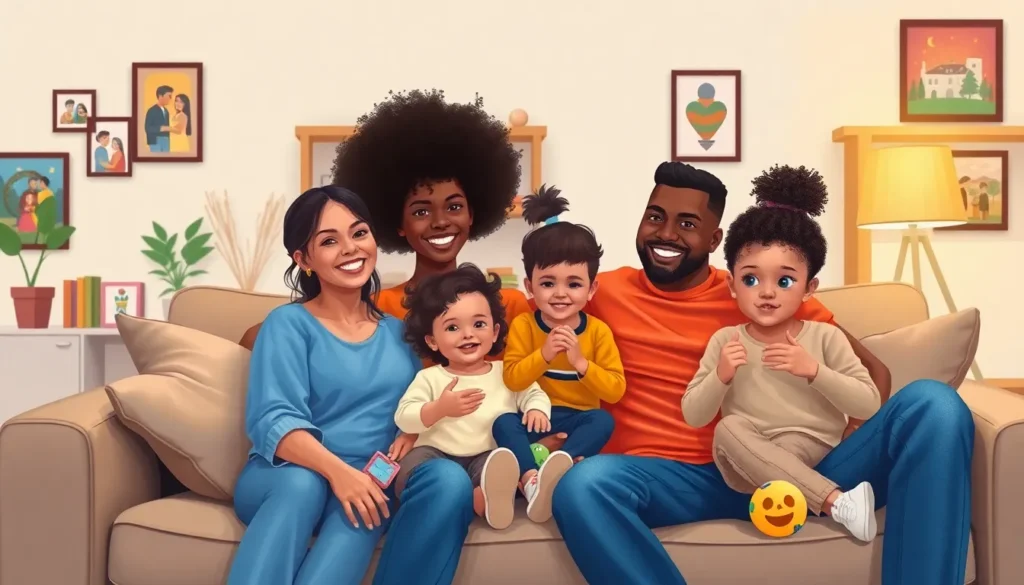Table of Contents
ToggleNavigating the world of child care can feel like trying to solve a Rubik’s Cube while blindfolded. Two terms often thrown around are adoption and fostering, but they’re not interchangeable. Think of adoption as the ultimate commitment—like deciding to marry your favorite pizza place. Fostering, on the other hand, is more like a delicious slice you enjoy temporarily while waiting for your own pie to be delivered.
Understanding Adoption
Adoption serves as a crucial pathway for families to create lasting bonds with children. This process permanently transfers parental rights, establishing a legal relationship between the adoptive parents and the child.
Definition of Adoption
Adoption involves a legal procedure whereby an individual or couple assumes parental responsibility for a child. It establishes a permanent family relationship. Different from fostering, adoption entails a commitment that lasts a lifetime. The child gains a new family, while the biological parents’ rights are relinquished. Families often pursue adoption for various reasons, including infertility, a desire to provide a loving home, or to help children in need.
Types of Adoption
Types of adoption vary significantly. Domestic adoption concerns children within the same country; families adopt them through public or private agencies. International adoption involves bringing a child from another country into a family’s home. Stepparent adoption occurs when a stepparent seeks to adopt their partner’s child, solidifying their parental role. Additionally, foster-to-adopt allows foster parents to transition into adoptive parents when it’s in the child’s best interest. Each type offers unique experiences and requirements, reflecting diverse family dynamics.
Understanding Fostering

Fostering serves as a temporary care arrangement for children unable to live with their biological families. It provides a safe environment until a more permanent solution is found, such as reunification with parents or adoption.
Definition of Fostering
Fostering involves taking care of a child removed from their home due to various circumstances, including neglect or abuse. In this situation, foster parents provide daily care, love, and support. While fostering does not create a permanent parental relationship, it plays a crucial role in the child’s development and well-being during this transitional period.
Types of Fostering
Fostering can take several forms to meet specific needs. General foster care accommodates children from diverse backgrounds and ages. Respite care allows short-term placements to relieve full-time foster parents. Therapeutic fostering supports children with emotional or behavioral challenges. Each type addresses unique situations and offers vital support in the child welfare system.
Key Differences Between Adoption and Fostering
Adoption and fostering represent distinct approaches to childcare, encompassing different legal frameworks and emotional commitments.
Legal Aspects
Adoption establishes a permanent legal relationship between the child and the adoptive parents. Legal rights transfer from biological parents to adoptive parents, ensuring lifelong responsibility. Fostering, however, does not create a permanent legal bond. It remains a temporary arrangement, with biological parents retaining their parental rights unless a court decides otherwise. Each path involves specific legal procedures, but adoption culminates in an irreversibly changed family structure, whereas fostering focuses on temporary care.
Duration of Care
The duration of care in fostering varies widely but typically lasts until a child can reunite with their biological family or another permanent solution is reached. Foster placements can last from a few days to several years, responding to individual needs and circumstances. In contrast, adoption signifies a lifelong commitment. Once an adoption is finalized, the child becomes a permanent member of the family, fostering new bonds and stability.
Parental Rights
In adoption, parental rights shift entirely, granting adoptive parents full authority over the child’s welfare and upbringing. Biological parents lose their legal rights, creating a fresh start for the child and the adoptive family. Fostering keeps parental rights intact for biological families, allowing the possibility of reunification. Foster parents provide necessary care but do not assume legal parental authority. Understanding these differences helps clarify the unique roles each option plays in child welfare.
Benefits and Challenges
Adoption and fostering present unique benefits and challenges. Understanding these aspects aids families in making informed decisions.
Benefits of Adoption
Adoption fosters a permanent family bond between parents and children. Legal rights transfer completely from biological parents to adoptive parents, ensuring security and stability. Families pursuing adoption often experience a sense of fulfillment, knowing they provide a loving home to a child in need. Emotional connections thrive as families navigate life’s milestones together. Financial assistance, such as adoption subsidies, often supports adoptive families, alleviating some of the costs associated with child-rearing.
Benefits of Fostering
Fostering offers a chance to impact children’s lives during critical periods. It allows caregivers to provide a safe and nurturing environment when biological families face challenges. Flexibility characterizes the fostering experience, accommodating those unable to commit to permanent arrangements. Assistance from agencies and support systems reduces the challenges foster parents may face. Foster care also allows families to help multiple children over time, contributing to the community’s well-being.
Challenges of Adoption
Adoption involves distinct emotional and financial challenges. Potential adoptive parents often face lengthy processes, including home studies and background checks. Emotional struggles can arise from navigating the complexities of attachment and identity for both parents and children. Financial burdens may accompany adoption, particularly for international or special needs adoptions. Some families experience uncertainty around maintaining connections with biological families, adding to emotional complexities.
Challenges of Fostering
Fostering presents various difficulties for caregivers. Emotional attachment can complicate decisions when reunification with biological families occurs. Foster parents often grapple with instability, as children may move frequently between placements. Navigating relationships with biological families, social workers, and legal systems adds layers of complexity. Limited resources and support can strain foster parents, making the experience more challenging than expected.
Adoption and fostering each play vital roles in child welfare but serve different purposes. Adoption creates lasting family bonds through a permanent legal relationship, while fostering provides temporary care during challenging times. Both options come with unique rewards and challenges that can significantly impact children and families alike.
Understanding these distinctions is essential for anyone considering child care options. Each path offers opportunities for love and support, yet they require different commitments and emotional investments. By recognizing the differences between adoption and fostering, individuals can make informed decisions that align with their family goals and values.










